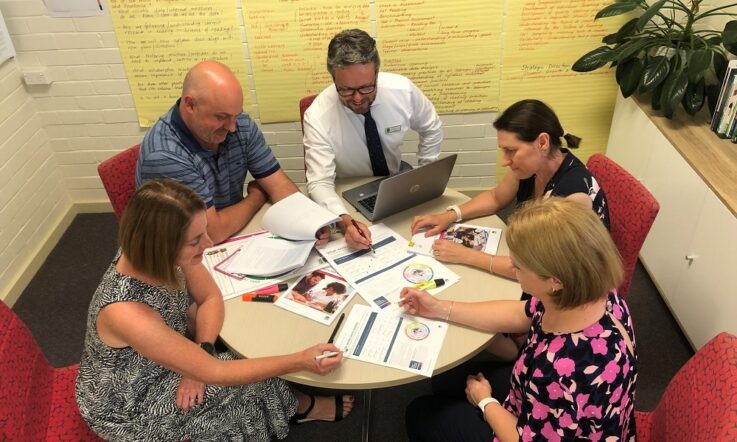‘Know thyself’ – pithy self-help aphorism? Impossible task? Life-changing wisdom? What really is the value of reflection? And how is it effectively taught?
In a world characterised by hurry, progress and efficiency, reflection requires a change of pace. It requires that we pause, breathe, and shift our future-orientation to dwell instead on what has been. This does not come naturally to many of the students in our classrooms (perhaps not even to ourselves).
Spurred on by research which links self-reflection to effective learning and memory formation (Briggs, 2015), personal growth (Feize & Faver, 2019) and wellbeing and life satisfaction (Harrington & Loffredo, 2011), the Christian Studies teaching team at Roseville College in New South Wales has been reading, sharing, experimenting and, indeed, reflecting on how we can help our students better know themselves. Here is some of what we have learned.
What is ‘good’ reflection?
We found it helpful early on to clarify what is meant by ‘good’ reflection’. It is not self-absorbed rumination and mere navel-gazing. It is not superficial or cliché. It is not about ticking boxes or saying what someone else wants to hear. Importantly (for this is where we realised we had significant scope to improve our practice), good reflection is far more than summarising, generalising and judging. Simply collecting student testimonials about how good or bad they found a particular experience is not pushing hard enough.
Instead, good reflection is ultimately transformative. While a wide range of definitions exist in the literature, they all tend to acknowledge that good reflection involves processing the past so as to change the future. It is marked by the search for deep understanding, honest examination, holistic integration and informed and deliberate growth. As educator Peter Drucker said: ‘Follow effective action with quiet reflection. From the quiet reflection will come even more effective action.’
What good reflection requires of teachers
As with many aspects of teaching, facilitating good reflection in our classrooms required that we be prepared and purposeful. As teachers, we needed to put in place the necessary supportive structures. These included having a stated purpose, surrounding discourse which is at an appropriate level of complexity, clarity regarding evidence of learning and possible methods of assessment, metacognitive guides, and opportunities to share and receive ongoing feedback throughout the process. However, much of this list applies to learning in general. What is specific to teaching students to reflect?
The literature here seems to highlight three themes worth exploring:
- The first is the importance of the stimulus. Be it a mining question, an emotive experience, an effective sentence stem or another tool entirely, this stimulus must be sufficiently targeted to elicit relevant reflections, sufficiently engaging to invigorate the mind, and sufficiently open-ended to allow for authenticity and depth.
- The second theme is the value of modelling. Bain and colleagues (2002) use the terminology of the five R’s to describe different levels of reflective thought. Articulating our own thinking in a way that demonstrates these various levels is of enormous benefit to students. But this requires a degree of humility and vulnerability; we must position ourselves as lifelong learners, works in progress, change agents, so as to encourage our students to see themselves thus.
- This brings us to the final distinctive theme, and that is the environment. Poole, Jones & Whitfield (2013) have written insightfully about the inherently threatening nature of good reflection and the associated need for a truly safe environment. They highlight the importance of autonomy, access and connection to others, feedback, time, meaningful links to objectives and significant performance demands, arguing: ‘These conditions acknowledge the emotional consequences of honest reflection, with its potential to challenge long-standing beliefs about the way the world works and the kind of person our student believes him or herself to be.’
Putting our learning into practice
We are building deliberate reflection opportunities into all of our high school classes, and experimenting with different forms and approaches. Here are three examples.
In Year 9, we are trying to create a regular practice of quiet personal reflection where our students respond to open-ended prompts. These prompts pick up on Biblical teachings we’ve been exploring, and we link these to the broader lives and cultural contexts of our students, covering themes such as conformity, resilience, gratitude and freedom. Students are given a lot of autonomy both in their responding and their sharing. Recently, they chose portions of their written reflections to be reviewed by their teachers and we have been encouraged by the growth we have seen. Most notably, we see progress over time in their ability to articulate their self-understanding in detail and to think critically about significant issues and key cultural messages.
In Year 10, our students engage in a study of apologetics, exploring varied responses to big philosophical questions about the connections between faith and science, or suffering, or the concept of truth. In line with our learning about reflection, we have adapted and applied the concept of empathy mapping. This is a simple visualisation model, often used in marketing and User Experience, which helps students consider where some of these complex and, often, emotive questions are coming from both with regards to their own assumptions and influences, and those of others. One of the most interesting outcomes of this strategy has been a shift in discourse, with class conversations becoming more sensitive and nuanced.
In Year 11, we teach an extended unit on Comparative Religions. But it is one thing to know some facts about other faiths, and another thing entirely to engage empathetically with people of other faiths while still holding firm to one’s own convictions. For our students, we want the latter. To this end, we took a new approach to assessment, adding creative and reflective layers. Students researched the life and practices of another religious tradition, and then reflected on how these compare to their own life and practices. They expressed this comparative reflection in a creative format of their choosing with an accompanying rationale. While we enjoyed the spread of artworks, daily schedules, diary entries and other creative submissions, we particularly appreciated the depth of reflection that had enabled our students to find (sometimes surprising) areas of commonality, along with an appreciation for diversity.
Teacher reflective practice
For our Department team, improving our reflective practice is an ongoing journey. We are reading widely, drawing on the expertise of others, experimenting with different models, carefully integrating reflection into our assessment practices, trying to build classroom environments grounded in trust, and developing a reflective culture within our team.
Our ultimate goals are lofty: experts argue that regular and meaningful self-reflection ultimately promotes well-being and personal growth (Harrington & Loffredo, 2011).
In the late 70s, theologian Richard J Foster, made this call: ‘…the desperate need today is not for a greater number of intelligent people, or gifted people, but for deep people’ (Foster, 2008). In teaching our students (and ourselves) to truly ‘know thyself’, we join the pursuit of this depth.
References
Bain, J.D., Ballantyne, R., Mills, C., & Lester, N.C. (2002). Reflecting on practice: Student teachers’ perspectives. Flaxton, QLD: Post Pressed.
Briggs, S. (2015). What meaningful reflection can do for student learning. Accessed online <opencolleges.edu.au/informed/features/meaningful-reflection>.
Feize, L. & Faver, C. (2019). Teaching self-awareness: social work educators’ endeavors and struggles. Social Work Education, 3892, 159-176.
Foster, R. J. (2008). Celebration of discipline: the path to spiritual growth. Hodder & Stoughton.
Harrington, R., & Loffredo, D. A. (2011). Insight, rumination, and self-reflection as predictors of well-being. Journal Of Psychology, 145(1), 39–57.
Poole, G., Jones, L., & Whitfield, M. (2013). Helping students reflect: lessons from cognitive psychology. Advances in Health Science Education, 18, 817-824.
If you’d like to share what’s happening in your own context through a Teacher Reader Submission – whether the focus is students, teachers, parents or the whole school community – take a look at our quick guide for contributors for more information.



